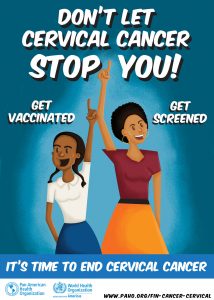
Among Caribbean women of all ages, cervical cancer is the second most common cancer in terms of incidence and mortality and accounts for 13% of all cancer cases and 10.4% of all cancer deaths in the region. Cervical cancer, is caused by persistent infection of the human papillomavirus (HPV), and is a highly preventable disease (PAHO). In the Caribbean, the highest cancer incidence rates are in Puerto Rico, Cuba and Suriname. In the English-speaking Caribbean, Bahamas, Barbados, Grenada, Guyana and Jamaica, breast and cervical cancers are the leading cancers in women, with more than 16,000 diagnosed and more than 6,000 dying from these diseases each year. The incidence rate for cervical cancer range between 20 to 80 out of every 100,000 women which is the highest in the region and if current trends continue it is expected increase by almost 40% by 2030.
This high rate persists in spite of the availability of Pap smear screening programs in most Caribbean countries. Vaccination of adolescent girls against HPV and screening of women are the best ways of preventing this disease. However, cervical cancer screening has achieved limited success due to lack of organized screening programs, the limitations of techniques, poor quality control, low population coverage, insufficient monitoring, treatment, and follow-up for women with abnormal cytology results, among other difficulties. Women from lower socioeconomic status, are often less educated than their higher socioeconomic status counterparts, and are often unaware of available screening programs or have no access to it. Therefore, despite the best efforts to organize screening programs by public health agencies and NGOs there has only been a moderate decrease in cervical cancer mortality in the region.
Finally, part of the solution is to strengthen public health systems in the region, and work towards increasing more access to screening and prevention programs through universal health coverage. This will require developing effective strategies for increasing more health education resources and training of more healthcare workers, and through integration of women’s cancer services into primary care services. This should also include more resources for the diagnosis, treatment, counseling and palliative care for women diagnosed with cervical cancer and ongoing financial resources to support programs that are effective and accessible to all women who are at risk.
Please Comment Below
You must be logged in to post a comment.